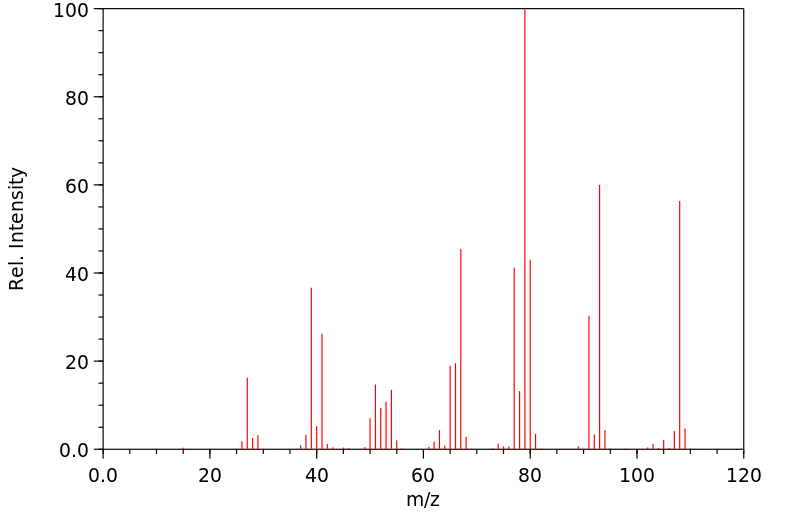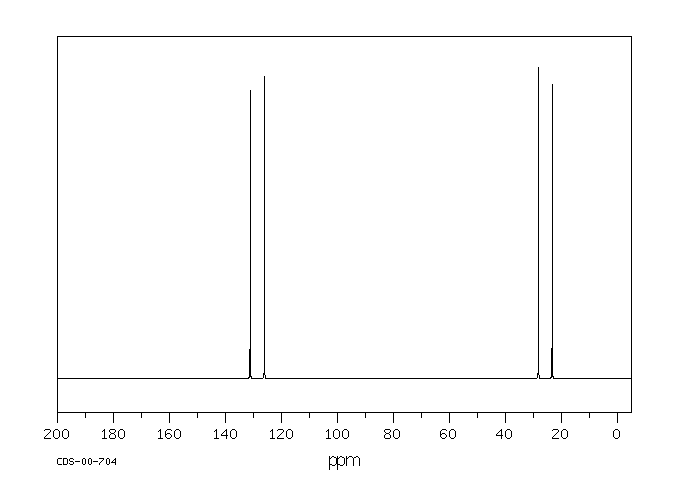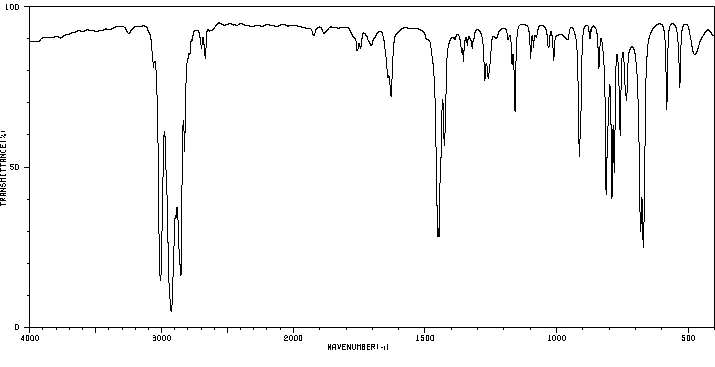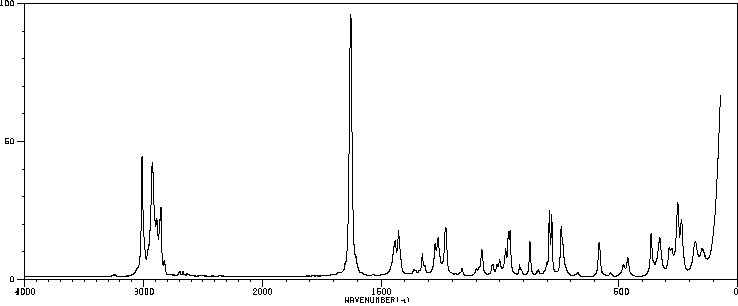环辛二烯 | 1700-10-3
中文名称
环辛二烯
中文别名
——
英文名称
1,3-cyclooctadiene
英文别名
cis,cis-1,3-cyclooctadiene;Cycloocta-1,3-diene;cyclooctadiene;(1Z, 3Z)-cycloocta-1,3-diene;(1Z,3Z)-cycloocta-1,3-diene
CAS
1700-10-3;29965-97-7
化学式
C8H12
mdl
——
分子量
108.183
InChiKey
RRKODOZNUZCUBN-CCAGOZQPSA-N
BEILSTEIN
——
EINECS
——
-
物化性质
-
计算性质
-
ADMET
-
安全信息
-
SDS
-
制备方法与用途
-
上下游信息
-
文献信息
-
表征谱图
-
同类化合物
-
相关功能分类
-
相关结构分类
物化性质
-
熔点:−53-−51 °C(lit.)
-
沸点:55 °C34 mm Hg(lit.)
-
密度:0.873 g/mL at 20 °C(lit.)
-
闪点:76 °F
-
物理描述:Cyclooctadienes appears as a liquid. May irritate skin and eyes. Less dense than water and insoluble in water. Used to make rubber.
-
保留指数:894
计算性质
-
辛醇/水分配系数(LogP):3.3
-
重原子数:8
-
可旋转键数:0
-
环数:1.0
-
sp3杂化的碳原子比例:0.5
-
拓扑面积:0
-
氢给体数:0
-
氢受体数:0
安全信息
-
TSCA:Yes
-
危险等级:3
-
危险品标志:T
-
安全说明:S26,S36,S45,S62
-
危险类别码:R10
-
WGK Germany:3
-
危险品运输编号:UN 2520 3/PG 3
-
海关编码:2902199090
-
包装等级:III
-
危险类别:3
SDS
制备方法与用途
环辛二烯
环辛二烯是一种重要的有机合成中间体,主要用来制备辛二酸、辛烯二酸和四氯环辛烷,同时也是聚酰胺纤维的单体和环氧树脂的活性稀释剂。
用途环辛二烯的主要用途包括:
制备过程- 催化剂配置:将溶剂甲苯从计量釜中抽入催化剂配置釜,确保水分低于350 ppm。
- 抽真空与置换:在真空度达到-0.09 MPa后进行氮气破空置换,重复三次,保持少量氮气流动。打开加料球阀加入3 kg乙醇,关闭阀门,并开启低温水和搅拌器。
- 三乙基铝的滴加:将28 kg(约35 L)30% 的三乙基铝分批缓慢加入催化剂配置釜中(通常三次),并保持反应温度低于35℃。在滴加过程中注意观察温度和压力变化,压力超过0.02 MPa时通过排压阀卸压。
- P与N催化剂的添加:在搅拌10分钟后停止搅拌,在氮气保护下加入9 kg P催化剂、1.5 kg N催化剂及10 kg甲苯的混合液。加完后重新开启搅拌器,注意温度和压力变化,并执行步骤3中的泄压操作。
- 催化体系转移:将配置好的催化剂转移到反应釜中。
- 丁二烯滴入:通过泵向丁二烯滴加罐内分两次加入1500 kg的丁二烯。在第一次反应投料时,向反应釜内打入400 L甲苯确保物料循环。
- 加料与搅拌:逐步向反应釜中加入丁二烯(前四批每次150 kg),并缓慢升温至85℃,根据放热程度调整列管反应器的循环水降温。控制反应温度低于110℃,压力降至0.2 MPa以下时可间歇式滴加丁二烯。
- 完成反应:当丁二烯总量达到1500 kg后停止加入,并在保温3小时后取样分析,确认反应结束。降温至40℃,压力降至0.1 MPa准备出料。
上下游信息
-
上游原料
中文名称 英文名称 CAS号 化学式 分子量 —— (1E,3Z)-1,3-cyclooctadiene 3806-60-8 C8H12 108.183 1,4-环状辛二烯 1,4-Cyclooctadien 1073-07-0 C8H12 108.183 —— 1,5-cis,cis-cyclooctadiene 111-78-4 C8H12 108.183 —— cyclooctene 3958-30-3 C8H14 110.199 -
下游产品
中文名称 英文名称 CAS号 化学式 分子量 —— (1E,3Z)-1,3-cyclooctadiene 3806-60-8 C8H12 108.183 1,4-环状辛二烯 1,4-Cyclooctadien 1073-07-0 C8H12 108.183 —— 1,5-cis,cis-cyclooctadiene 111-78-4 C8H12 108.183 顺-环辛烯 (Z)-Cyclooctene 931-87-3 C8H14 110.199 —— (1Z,3Z,5Z)-Cycloocta-1,3,5-triene 1871-52-9 C8H10 106.167 —— 2-Brom-1,3-cyclooctadien 57559-43-0 C8H11Br 187.079 —— Cycloocta-3,5-dien-1-one 80326-37-0 C8H10O 122.167 —— (3Z,5Z)-cyclooctadienol 10095-79-1 C8H12O 124.183 —— 5-deuterio-cis,cis-1,3-cyclooctadiene 121824-94-0 C8H12 109.175
反应信息
-
作为反应物:描述:参考文献:名称:Taskinen, Esko; Nummelin, Kari, Acta chemica Scandinavica. Series B: Organic chemistry and biochemistry, 1985, vol. 39, # 9, p. 791 - 792摘要:DOI:
-
作为产物:描述:参考文献:名称:CoCl 2 / Ph 3 P / NaBH 4体系催化的烯烃异构化摘要:在-10℃下使用CoCl 2 / Ph 3 P / NaBH 4在THF中以1/3/1的比例原位产生的催化剂将1-癸烯异构化成主要为顺-2-癸烯或反式-2-癸烯。烯丙基苯和黄樟脑已经转化为相应的β-甲基苯乙烯。该催化剂还将顺式,顺式-1,5-环辛二烯异构化为顺式,顺式-1,3-环辛二烯。DOI:10.1016/0022-328x(87)80353-4
-
作为试剂:参考文献:名称:PROCESS FOR PREPARING CYCLODODECATRIENE摘要:采用催化剂体系和溶剂,在连续或间歇过程中通过丁二烯三聚制备环十二烯,得到的粗环十二烯可以通过蒸馏分离。同时,产生的环辛二烯也可以从粗产品中分离出来。公开号:US20070265184A1
文献信息
-
Hydrazines and Azides via the Metal-Catalyzed Hydrohydrazination and Hydroazidation of Olefins作者:Jérôme Waser、Boris Gaspar、Hisanori Nambu、Erick M. CarreiraDOI:10.1021/ja062355+日期:2006.9.1which the H and the N atoms come from two different reagents, a silane and an oxidizing nitrogen source (azodicarboxylate or sulfonyl azide). The hydrohydrazination reaction using di-tert-butyl azodicarboxylate is characterized by its ease of use, large functional group tolerance, and broad scope, including mono-, di-, tri-, and tetrasubstituted olefins. Key to the development of the hydroazidation报道了 Co 和 Mn 催化的烯烃加氢肼和加氢叠氮化反应的发现、研究和实施。这些反应等效于 CC 双键与受保护的肼或偶氮酸的直接加氢胺化,但基于不同的概念,其中 H 和 N 原子来自两种不同的试剂,硅烷和氧化性氮源(偶氮二羧酸或磺酰叠氮化物) )。使用偶氮二羧酸二叔丁酯的加氢肼反应具有使用方便、官能团耐受性大、适用范围广的特点,包括单、二、三和四取代烯烃。氢叠氮化反应发展的关键是使用磺酰叠氮化物作为氮源和叔丁基过氧化氢的活化作用。发现该反应对于单、二和三取代烯烃的官能化是有效的,并且只有少数官能团是不能容忍的。获得的烷基叠氮化物是通用中间体,可以在不分离叠氮化物的情况下转化为游离胺或三唑。初步的机理研究表明,烯烃的氢化钴是限速的,然后是胺化反应。不能排除并可能涉及自由基中间体。然后进行胺化反应。不能排除并可能涉及自由基中间体。然后进行胺化反应。不能排除并可能涉及自由基中间体。
-
Stereospecific palladium-catalyzed 1,4-acetoxychlorination of 1,3-dienes作者:Jan-E. Bäckvall、Ruth E. Nordberg、Jan-E. NyströmDOI:10.1016/s0040-4039(00)87173-7日期:1982.1Palladium-catalyzed oxidation of 1,3-dienes in acetic acid in the presence of LiCl and LiOAc produces 1-acetoxy-4-chloro-2-alkenes in high selectivity. The 1,4-adducts were stereo- and regioselectively functionalized.
-
Palladium–Platinum Bimetallic Nanoparticle Catalysts Using Dendron Assembly for Selective Hydrogenation of Dienes and Their Application to Thermomorphic System作者:Makoto Murata、Yuko Tanaka、Tomoo Mizugaki、Kohki Ebitani、Kiyotomi KanedaDOI:10.1246/cl.2005.272日期:2005.2Self-assembly of dendrons allows a new approach for size control of bimetallic Pd–Pt nanoparticles, which affords reusable dendritic nanoreactors for selective hydrogenation of dienes and alkynes to monoenes in thermomorphic systems.
-
Flash vacuum pyrolysis over magnesium. Part 1. Pyrolysis of benzylic, other aryl/alkyl and aliphatic halides作者:R. Alan Aitken、Philip K. G. Hodgson、John J. Morrison、Adebayo O. OyewaleDOI:10.1039/b108663d日期:2002.1.23Flash vacuum pyrolysis over a bed of freshly sublimed magnesium on glass wool results in efficient coupling of benzyl halides to give the corresponding bibenzyls. Where an ortho halogen substituent is present further dehalogenation gives some dihydroanthracene and anthracene. Efficient coupling is also observed for halomethylnaphthalenes and halodiphenylmethanes while chlorotriphenylmethane gives 4,4′-bis(diphenylmethyl)biphenyl. By using α,α′-dihalo-o-xylenes, benzocyclobutenes are obtained in good yield, while the isomeric α,α′-dihalo-p-xylenes give a range of high thermal stability polymers by polymerisation of the initially formed p-xylylenes. Other haloalkylbenzenes undergo largely dehydrohalogenation where this is possible, in some cases resulting in cyclisation. Deoxygenation is also observed with haloalkyl phenyl ketones to give phenylalkynes as well as other products. With simple alkyl halides there is efficient elimination of HCl or HBr to give alkenes. For aliphatic dihalides this also occurs to give dienes but there is also cyclisation to give cycloalkanes and dehalogenation with hydrogen atom transfer to give alkenes in some cases. For 5-bromopent-1-ene the products are those expected from a radical pathway but for 6-bromohex-1-ene they are clearly not. For 2,2-dichloropropane and 1,1-dichloropropane elimination of HCl occurs but for 1,1-dichlorobutane, -pentane and -hexane partial hydrolysis followed by elimination of HCl gives E,E-, E,Z- and Z,Z- isomers of the dialk-1-enyl ethers and fully assigned 13C NMR data are presented for these. With 6-chlorohex-1-yne and 7-chlorohept-1-yne there is cyclisation to give methylenecycloalkanes and -cycloalkynes. The behaviour of 1,2-dibromocyclohexane and 1,2-dichlorocyclooctane under these conditions is also examined. Various pieces of evidence are presented that suggest that these processes do not involve generation of free gas-phase radicals but rather surface-adsorbed organometallic species.在玻璃棉上覆盖一层新升华的镁,进行闪式真空热解,能有效促使苄基卤化物耦合生成相应的联苄。当有邻位卤素取代基存在时,进一步脱卤生成部分二氢蒽和蒽。卤甲基萘和二苯基甲烷也能高效耦合,而三苯基氯甲烷则生成4,4′-双(二苯甲基)联苯。用α,α′-二卤代邻二甲苯可以获得较高产率的苯并环丁烯,而异构的α,α′-二卤代对二甲苯,通过形成的对二甲苯的聚合,可以得到一系列高热稳定性的聚合物。其他卤代烃苯大体上会脱卤化氢,某些情况下能产生环化反应。同样可以观察到,苯基卤代烷烃脱去羰基生成苯乙炔以及其他产物。简单的烷基卤化物则高效地脱去HCl或HBr生成烯烃。脂肪族二卤化物也会发生这一反应生成二烯,但不发生环化反应生成环烷烃,或在某些情况下发生氢原子转移的脱卤反应生成烯烃。5-溴戊-1-烯的产物符合自由基途径的预期,但6-溴己-1-烯并不符合。2,2-二氯丙烷和1,1-二氯丙烷能脱去HCl,但1,1-二氯丁烷、戊烷和己烷则能部分水解,随后脱去HCl,生成E,E-, E,Z-和Z,Z-异构体二烷-1-烯基醚,并且得到了这些物质的13C NMR全归属数据。6-氯己-1-炔和7-氯庚-1-炔能发生环化反应生成亚甲基环烷烃和环炔烃。本文还考察了1,2-二溴环己烷和1,2-二氯环辛烷在上述条件下的行为。本文给出了众多种证据,表明这些反应过程不涉及气相自由基的形成,而是表面吸附的金属有机物种。
-
An Efficient, Overall [4+1] Cycloadditon of 1,3-Dienes and Nitrene Precursors作者:Qiong Wu、Jian Hu、Xinfeng Ren、Jianrong Steve ZhouDOI:10.1002/chem.201101630日期:2011.10.4Intermolecular cycloadditions of conjugated dienes and nitrene precursors usually produce aziridines. A generally useful method was lacking to directly provide the [4+1] cycloadducts, 3‐pyrrolines. We have realized this transformation by using an uniquely active catalyst, copper(II) 1,1,1,5,5,5‐hexafluoroacetylacetonate ([Cu(hfacac)2]). The method is applicable to a wide array of dienes with good yields
表征谱图
-
氢谱1HNMR
-
质谱MS
-
碳谱13CNMR
-
红外IR
-
拉曼Raman
-
峰位数据
-
峰位匹配
-
表征信息
同类化合物
高密聚乙烯
香叶醇
顺式3-甲基-2-己烯
顺式-5-癸烯
顺式-5-甲基-2-己烯
顺式-5-庚烯-1-炔
顺式-4-癸烷
顺式-4-甲基-2-戊烯
顺式-4-甲基-2-戊烯
顺式-3-癸烯
顺式-3-甲基-3-己烯
顺式-3-甲基-2-庚烯
顺式-3-戊烯-1-炔
顺式-3,4-二甲基-3-己烯
顺式-3,4-二甲基-2-戊烯
顺式-3,4-二甲基-2-戊烯
顺式-2-甲基-3-己烯
顺式-2-壬烯
顺式-2-丁烯-D1
顺式-1.1.1-三甲基-2-丁烯
顺式-1-甲基-2-环丙基乙烯
顺式-1-甲基-2-乙烯基环戊烷
顺式-1-环戊基-1-辛烯
顺式-1-氘代-3-甲基-1-丁烯
顺式-(9ci)-2,3,3a,7a-四氢-4-(1-甲基乙基)-1H-茚
顺式-(2-丁烯基)环丙烷
顺式,顺式-2,4-己二烯
顺-环辛烯
顺-9-二十一碳烯
顺-6-十三碳烯
顺-5-甲基-1,3,6-庚三烯
顺-4-辛烯
顺-4-壬烯
顺-3-辛烯
顺-3-甲基-2-戊烯
顺-3-壬烯
顺-3-十三碳烯
顺-2-辛烯
顺-2-癸烯
顺-2-戊烯
顺-2-庚烯
顺-2-己烯
顺-2-丁烯
顺-2,2-二甲基-3-己烯
顺-1,3-戊二烯
顺,顺-1,9-环十六烷二烯
顺,顺,顺-环癸-1,3,5-三烯
间戊二烯
间二(4-吡啶基)苯
镁,二-2-丁烯基-











